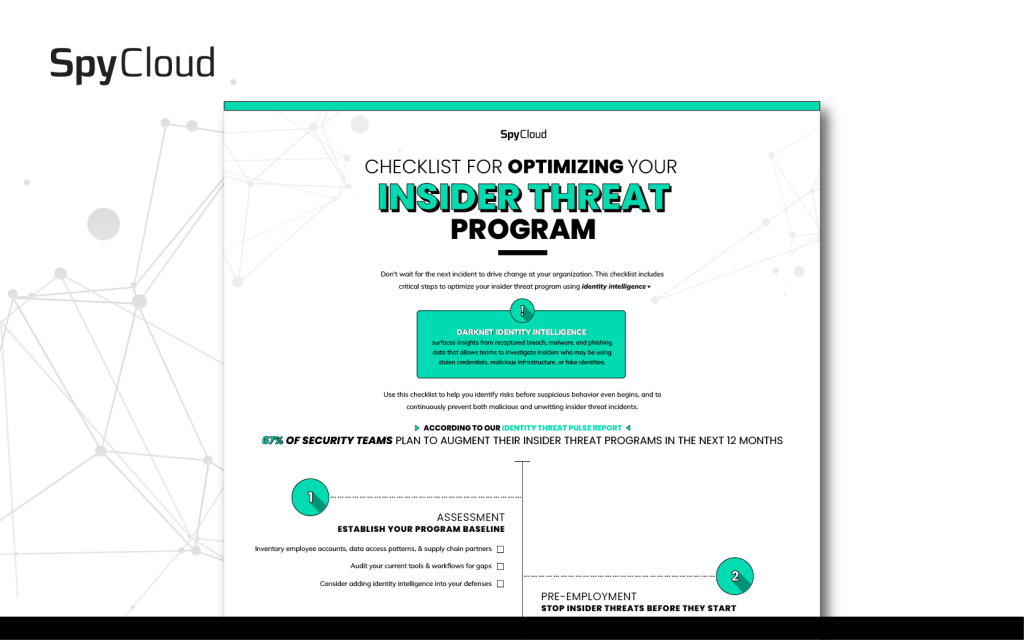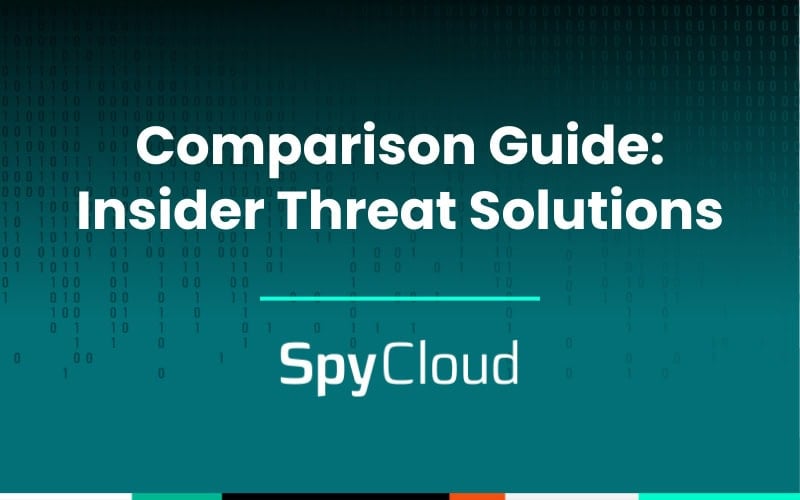A template for proactively detecting malicious, negligent, and fraudulent insiders
Insider threats are no longer a rare or hypothetical risk. With 56% of organizations experiencing insider threat incidents recently – and despite many having formal programs – it’s clear that something isn’t working with the status quo.
Traditional tools excel at detecting suspicious behavior once someone’s operating inside your network, but they’re not built to catch hidden threats that bypass classic detection mechanisms entirely.
This checklist provides actionable steps to optimize your insider threat program using identity intelligence that reveals risks before suspicious behavior even begins, giving you a leg up on preventing future incidents.
The new norm when it comes to insider threats
SIEM, DLP, and UEBA solutions are important parts of your insider threat detection program, but they can’t see threats from a dark web perspective, which surfaces warning signals before behavioral anomalies surface. Insider threats – whether negligent employees with exposed credentials or malicious actors – are now a systemic risk, amplified by remote work, identity sprawl, and even state-sponsored infiltration.
The realities of today’s insider threat landscape are that:
INSIDER THREATS ARE ABUNDANT
56% of organizations we surveyed experienced an insider threat incident in the past year, even though 64% have formal insider threat programs in place.
ALERT FATIGUE IS REAL
Security teams unanimously report being overwhelmed by noisy DLP and UEBA alerts, making it difficult to distinguish real threats from normal behavior, and to properly allocate resources.
NATION-STATE INFILTRATION IS WIDESPREAD
Nearly every Fortune 500 company has received applications from fraudulent North Korean IT workers using stolen identities, and many have inadvertently hired them.
COORDINATION GAPS PERSIST
60% of security teams coordinate about job candidates and employees with HR through informal chats and manual processes, as opposed to unified and strategic workflows, leaving dangerous gaps in the hiring, ongoing verification, and offboarding processes.
If you don’t have a formal insider threat program or framework, now is a critical time to make one. And if you already have one, be sure to revisit, involve other teams, and augment it further with identity intelligence to prevent all forms of insider threats.
Use this checklist as a template for optimizing your program.
Establishing an insider threat program for your organization: Step-by-step template & checklist
ASSESSMENT: Establish your baseline
Setting a baseline is the foundation of any effective insider threat security program. Start by conducting a comprehensive assessment of your current program. What tools do you already have at your disposal? Which workflows are in place? Which stakeholders are involved?
This baseline should also include an inventory of privileged accounts, documentation of typical data access patterns, and a clear understanding of your third-party vendor relationships.
-
Inventory accounts, data access patterns, and supply chain partners
Make sure you understand your organization's normal user behavior patterns, access levels, and data flows before you begin steps to augment your program. -
Audit your current insider threat detection program
Map which tools and workflows you currently have available that help you address insider threats. Traditionally, enterprises use a combination of SIEM, DLP, and UEBA tools. Note any gaps within existing systems and processes. -
Consider adding identity intelligence into your defenses
Identity misuse is the common thread behind both negligent and malicious insiders, and identity intelligence gives you earlier warning signals that wouldn’t get flagged by other tools.
PRE-EMPLOYMENT: Stop insider threats before they start
Optimizing your program means helping HR and Security Operations join forces to verify identities before granting access. Augment your hiring process with enriched identity intelligence to flag high-risk candidates before extending an offer. When you vet against darknet identity assets, patterns emerge that background checks miss entirely.
-
Establish cross-functional response workflows
Create clear escalation paths and shared playbooks between security and HR teams with defined roles, responsibilities, and success metrics for different threat scenarios. -
Enhance background checks with darknet identity intelligence
Cross-reference job candidates against exposed darknet data to:- Discover identity assets that reveal fraudulent personas or nation-state operatives using synthetic identities
- Detect candidates tied to multiple disconnected identities or suspicious infrastructure patterns that indicate coordinated fraud
- Identify activity on criminal underground sites, usage of criminal-favored tools (like VPN technology or remote access tools), or credential patterns across multiple exposed, and potentially fraudulent, identities
-
Share exposure intelligence report results with HR to help clear or disqualify candidates
Summarize any evidence of compromised identities into intelligence reports for HR to help them identify potential threats and quickly disqualify any job candidates. See how SpyCloud Investigations with AI Insights does this for you -
Train recruiters on insider threat indicators
Educate HR teams to recognize red flags like inconsistent work histories or fraudulent companies, in addition to evidence of identity compromise from darknet sources.
Why identity intelligence flips the script: Traditional insider threat tools wait for suspicious behavior. SpyCloud reveals identity compromise before it becomes network access by analyzing 850+ billion stolen identity assets from breaches, malware and phishing attacks circulating on the criminal underground.
CONTINUOUS MONITORING: Detect emerging insider risks
A robust insider threat program, informed by frameworks like Zero Trust, requires continuous visibility into identity risk. You’ll want to continually evaluate employee identities for compromise as their digital exhaust often reveals hidden indicators of risk.
-
Identify high-risk user populations
Prioritize privileged users, remote workers, contractors, and recent hires for enhanced identity monitoring and verification. -
Monitor employee identity exposure across corporate and personal accounts
Continuously scan for employee credentials in malware, phished, and breached records, and even infected personal devices that expose corporate access. -
Track session cookie theft and invalidate compromised sessions
Monitor for stolen session cookies that bypass MFA and SSO, automatically invalidating affected sessions to prevent unauthorized access. -
Layer identity intelligence into SIEM and UEBA tools
Enrich behavioral alerts with identity exposure context to reduce false positives and focus investigations on employees with confirmed evidence of compromise. -
Continuously verify employee identities
Re-verify employee identities for your entire workforce, with quarterly checks for privileged users, remote workers, and those accessing sensitive systems.
“At the end of the day, ongoing identity verification helps organizations detect and prevent insider threats and stay ahead of attackers by leveraging the same intelligence they rely on to exploit identities.”
SUPPLY CHAIN: Extend your insider threat program to account for partners and vendors
It’s no secret that identity-related incidents have moved beyond traditional security perimeters to suppliers and vendors. A mature insider threat program has to reflect this perspective, which includes the supply chain, as compromised identities within it could expose unauthorized access to corporate applications.
-
Vet vendor and contractor identities
Apply identity validation processes to third-party workers accessing your systems, including temporary contractors and remote workers. -
Monitor partner organizations for compromises
Track malware, phished, and breached exposures affecting your vendors' and notify them of risks that could impact your organization. -
Incorporate identity exposure into vendor threat indices
Incorporate darknet exposure levels into vendor risk assessments to prioritize security controls and contract requirements.
Recent SpyCloud research shows 75% of security professionals are very concerned about supply chain exposures leading to follow-on attacks, and rightfully so. Vendors and supply chain partners with privileged access are prime targets to become entry points for attackers.
RESPONSE & REMEDIATION: Act fast on confirmed insider threats
A fully optimized insider threat program includes ways to detect hidden threats as well as processes for fully remediating unauthorized access – including resetting application credentials and invalidating session cookies to eliminate post-infection risk. SpyCloud’s Identity Threat Report found only 54% of organizations routinely reset passwords after malware infections and just 33% invalidate exposed user sessions after malware infections. And only 19% can automate identity remediation – meaning 81% do this manually!
-
Integrate with identity providers for automated protection
Connect with your identity provider – like Okta, EntraID, or Active Directory – to automatically reset compromised passwords and invalidate session cookies based on identity exposure intelligence. -
Provide complete remediation scope
Fully remediate all known access to exposed corporate applications requiring credential resets, using identity intelligence to visualize the extent of compromise. -
Automate response for critical exposures
When identity exposure is confirmed, automatically disable accounts and revoke sessions through SIEM, SOAR, and IdP integrations without manual intervention.
OFFBOARDING: Secure complete identity lifecycles
Optimizing your insider threat program is a continuous effort, extending detection until you’ve confirmed all access points that could cause threats have been closed. While your team may already account for behavioral changes such as emotional displays during termination, even negligent threats can lead to damage long after officially being de-provisioned. This damage can result from hidden access that could be exploited by criminals.
-
Map and revoke all access tied to departing employees
Use identity correlation to identify accounts, shadow IT applications, and third-party services connected to corporate identities for preventing any unauthorized access. -
Verify all access is terminated after employment
Integrate identity intelligence with existing access tracking to easily revoke access to any systems or applications. -
Coordinate security and HR actions during offboarding
Implement simultaneous access revocation and identity cleanup procedures to prevent insider threats during the vulnerable offboarding window.
Taking action: Your next steps
The evolution of insider threats requires a fundamental shift: Instead of waiting for suspicious behavior, detect identity compromise before it becomes network access.
About two-thirds (67%) of security teams report that they are planning to augment their insider threat programs in the next 12 months. Don’t wait for the next incident to drive change at your organization.
SpyCloud exposes fraudulent workers before HR onboards them, surfaces insider risk signals your SIEM or DLP miss, and shuts down threats in minutes.



